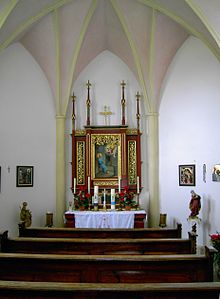Secret ailments

The passions of Jesus Christ that are not contained in the New Testament Passion story , are unknown and are only written down through private revelations , are referred to as secret sufferings .
The view that the tradition by the evangelists is incomplete can already be found among medieval scholastics ( Anselm of Canterbury : Dialogus c10: PL 159, 282C; Pseudo-Bonaventure : Meditationes 10: 121, 11-13 ed. Stallings). Especially in the vernacular writings in the Netherlands, the idea was further developed in the 15th century ( Johannes Brugman : Leven van Jezus ) and the term von der heimelike passie was first used in the title of an anonymous script.
In the Catholic popular piety of the 17th and 18th centuries, their memory was considered particularly effective for the forgiveness of sins. One of them included u. a. piercing the tongue ("They pierced me with various weapons") and chaining in the extended position ("Christ on the triangle"). Numerous devotional pictures and writings on the subject have been handed down, such as the prayer sheet “The 15 Secret Sorrows” in various versions, which supposedly goes back to a private revelation by Clarisse Magdalena Beutler († 1458).
The preoccupation of the holy Crescentia with the dungeon suffering of Christ generated renewed attention in her circle for the “secret sufferings” and is seen as the root of the related devotion and artistic processing of the subject from the 18th century.
Individual evidence
- ↑ a b Gerhard Müller (Ed.): Theologische Realenzyklopädie . Study edition . Vol. 27: Politics / Political Science-Journalism / Press. Berlin / New York: de Gruyter, 2000. Entry “Passion Piety”, p. 745. [1]
- ↑ Central Institute for Sepulchral Culture Kassel (ed.): Large Lexicon of Funeral and Cemetery Culture . Dictionary of Sepulchral Culture . Vol. 1. Braunschweig: Thalacker, 2002. Entry "Geheime Leiden (Christ)"
- ^ Elfriede Grabner : Hidden popular piety; Page 77 in the article “The Persistence of Unknown Suffering Motifs in Writing and Illustrations ”; Böhlau, 1997 ISBN 3-205-98760-8
literature
- Friedrich Zoepfl : The unknown suffering of Christ in the piety and art of the people . In: Volk und Volkstum. Jahrbuch für Volkskunde 2, 1937. pp. 317–336.
- Fritz Markmiller: A special picture of the secret suffering. On the iconography of "Christ on the Triangle" . In: Volkskunst 2, 1979. pp. 176-184.
- Fritz Markmiller: New Evidence for the Image Form of the Secret Sufferings of Christ . In: Volkskunst 4, 1981. pp. 98-105.
- E. Grabner: Word and picture testimony to the veneration of the "secret passion of Christ" . In: H. Eberhardt et al. (Ed.): Popular piety. Lectures at the Austrian Folklore Conference 1989 in Graz . (= Book series of the Austrian magazine for folklore NS 8). Vienna, 1990. pp. 127-136.
- O. Moser: The fifteen secret sufferings of Christ. According to an oral tradition from Carinthia . In: Österreichische Zeitschrift für Volkskunde 95, 1992. pp. 483–494.
- Nina Gockerell: "You pierced me with all kinds of weapons ...". Newly acquired works of art on the subject of Secret Sorrows as a supplement to the Kriss Collection in the Bavarian National Museum. In: piety. Forms, history, behavior, testimonies. Festschrift for Lenz Kriss-Rettenbeck . Munich, 1993. pp. 161-194.
- Nina Gockerell: Images and signs of piety . Munich, 1995. pp. 59-69, 84.
